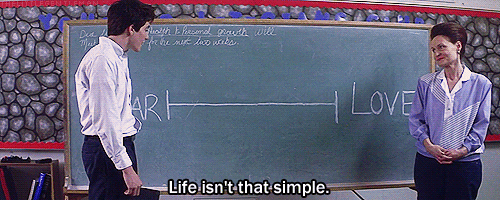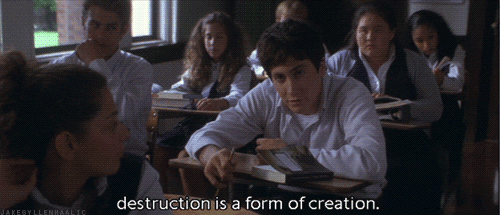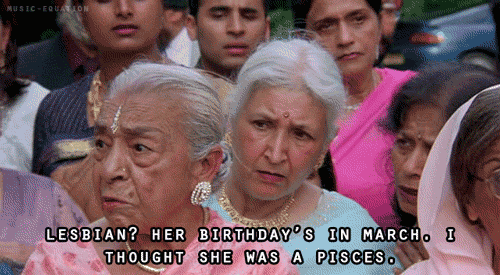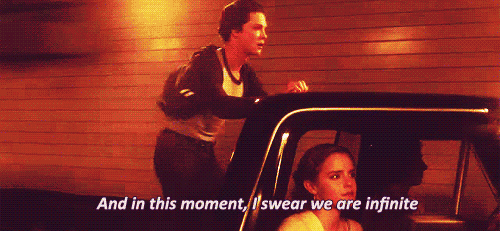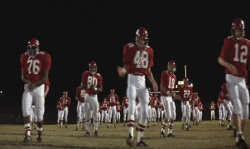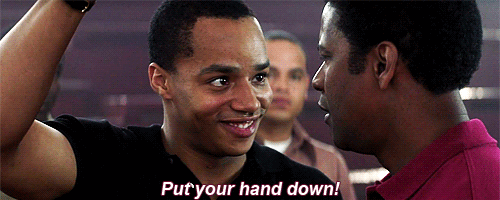Bibliographic
Information: Cross, P., Day, J. (Producers), & Zwigoff, T. (Director).
(2002). Ghost world. [DVD]. United
States: MGM.
Starring: Thora
Birch, Scarlett Johansson, Steve Buscemi
Plot Summary: “High
school is like the training wheels for the bicycle of real life,” says the girl
in a head-brace, giving a commencement speech. Enid frowns in the audience and
rolls her eyes, looking towards her best friend, Rebecca, and they laugh. They have
been best friends since always, and can’t wait to get an apartment together
this summer. But when Enid unrolls her diploma, she finds out that she is
required to take a remedial summer art class, which will delay their plans. At
the graduation dance, the girls encounter some of their classmates who seem to
have their whole lives planned, acting classes, college, scholarships—but the
girls, as usual, scoff and sneer at everyone.
They
continue on through summer as if high school never ended, meeting at cheesy
50’s theme diners and making fun of people. One day, they look in the personals
to find their “future husbands” and prank call one of the ads, setting up a blind date with a man named Seymour.
He shows up at the diner, but they just make fun of him from far away. Feeling
remorseful, Enid wants to follow him. They find him selling vinyl records at
his apartment, where their friendship sparks.
Meanwhile,
Rebecca is focused on getting the apartment, figuring that if they dress like
yuppies, they will have a better chance. Enid dyes her hair green instead. When
she is made fun of for trying to be “punk” she dyes it back to black. She
listens to the record she bought from Seymour, falling in love with one of the
blues tracks.
Rebecca
gets a job as a barista, and seems to gain a better grasp on adult life, while
Enid still struggles with every job she gets (quitting on the first day) and
simultaneously struggling to succeed in art class, where her teacher is pushing
her to create art that has a deeper meaning.
The
girls grow apart, as Rebecca is more sure of who she is and what she wants, and
Enid is in the opposite situation. Enid eventually decides to get on a
mysterious bus and leaves her life behind.
Critical Evaluation: Based
on the acclaimed graphic novel of the same name, Ghost World tackles issues of identity, isolation, racism, and
growing up. We watch the two female characters grow up and grow apart, as each
is faced with different challenges. Enid is usually ridiculed by boys for being
Jewish, while her blonde and beautiful best friend Rebecca has to dodge their
constant come-ons. We can see Enid’s frustration in the scene where she dyes
her hair green and back to black—a reflection of her inability to take on any
one identity.
Neither of the girls plan to go to
college, and Rebecca’s dream of having her own apartment seems shallow, as she
becomes obsessed with buying blue tumblers and other domestic accessories.
Enid’s great struggle is with her art. When she finds out that Seymour’s place
of work used to have a racist name and logo, she submits a giant “sambo” poster
to an art show. The startling image gains immediate negative response from the
crowd, and she is failed and loses an art scholarship. Her teacher was the only
person who understood the message she was trying to send: racism used be out in
the open, and now its still there, just hidden. Enid knows from experience.
The positive message lies within
Enid’s art journal. Throughout the film, she draws doodles of Seymour and
herself. So when she gets on the bus at the end, we can only hope that she is
pursuing art, but maybe in a less conventional way (like through the graphic
novel medium that this story was originally told in.)
Reader’s Annotation: Follow
Enid and Rebecca, social outcasts, best friends, and recent high school
graduates, as they struggle with first jobs, love, and identity.
Director Information:
The Internet Movie Database (IMDb) states: “Born in Appleton, Wisconsin, Zwigoff held several jobs before
making his breakthrough feature: the documentary Crumb (1994) in 1994. His previous
jobs included musician, shipping clerk, printer and welfare office worker.
Even with the enormous success of "Crumb", Zwigoff
refused to sell out to Hollywood. His aversion to corporate commercialism is a
well-known trademark. He turned down many more commercial projects while he
struggled for five years to make a feature film out of Daniel Clowes's
underground comic strip "Ghost World". Released in 2001, Ghost World
(2001) became the summer art house hit and captured Golden Globe nominations
for Steve Buscemi and Thora Birch, who played the teenage protagonist Enid.
"Ghost World" also brought acclaim for Zwigoff and his
co-screenwriter Daniel Clowes, a nomination for Best Adapted Screenplay in the
2002 Academy
Awards.
Ghost World wound up on over 150 Ten Best Lists for 2001.”
http://www.imdb.com/name/nm0959062/bio
Genre: Drama
Subjects: adulthood,
graduation, friendship, love, racism, art
Curriculum Ties: N/A
Booktalking Ideas: What
are the differences between Enid and Rebecca, and how does each character
navigate the adult world?
How does racism effect Enid and her art?
Reading
Level/Interest Age: 16+
Challenge
Issues/Defense: Due to profanity and sexual themes, this movie may be
challenged. If so, refer to:
4. Mixed reviews and list of awards won and nominated for.
Reasons for
Selection: This was one of my favorite movies in high school, it
complements the popular graphic novel well, and stars popular actors. Teens
with an affinity for alternative lifestyles and music, will love the punk
references, and obsession with vinyl records by Enid and Seymour. But most
importantly, teens will identity with the struggle to fit into the adult or
“ghost” world. the film was nominated for many awards, including an Oscar, and won many others.





